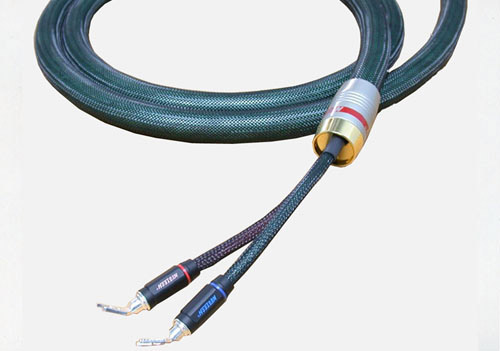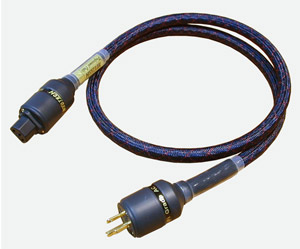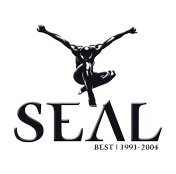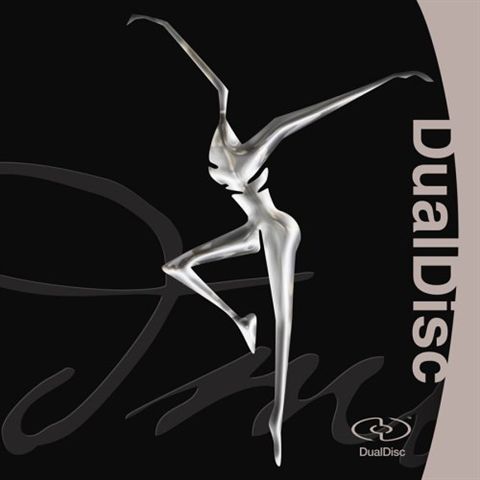NeoTech NES series cables
|
Cables Not from The MATRIX |
|
|
|
October 2005 |

Introductions and Previous Experiences
I first heard about NeoTech when I was surfing the Audiocom International site for component part upgrades (Super Clocks, Regulators, wire, etc). I came across an ad for replacement female IEC connectors using UP-OCC (ultra pure Ohno Continuous Cast) copper with 24K gold plating. As upgrades go, this appeared to be a low cost/risk adventure so I ordered three of them. After installing these connectors on the ends of my Foundation Research power line conditioners (replacing the stock Schulter IEC connectors), I reinserted the upgraded FR power line conditioners. I didn’t expect much of an improvement considering that the rest of the wire used in the FR line conditioner did not use UP-OCC wire but I was in for a pleasant surprise. As the NeoTech IEC connectors broke in, the most noticeable change was in the clarity of the midrange. The grittiness I had heard in my system when listening to both male and female vocals was removed. This upgrade was clearly worth the price of admission.
I later learned that NeoTech which originally supplied cable materials in raw form to OEMs, started to manufacture and market their own line of cables. The parent company of the NeoTech cable lines is Wan Lung Electric of Taiwan.
At the heart of NeoTech’s cable design is the use of UP-OCC copper and silver metallurgy employing the continuous-casting method as developed by Professor Ohno of the Chiba Institute in Japan. The unidirectional UP-OCC, being free from impurity (up to 99.99998% pure copper and silver) has electric resistance and practically no crystal boundaries. The net result is a cable with a signal path free of mechanical (electron collision) and electrical distortion as compared to oxygen free copper (OFC) and silver wires typically used in cable manufacturing. As a Materials Engineer, it easy for me to envision that an electrical signal transmitted through cable free of grain boundaries would sound more precise, focused, smoother, and less distorted, but the proof is in the hearing.
After contacting NeoTech to inquire about their current product offerings, they offered to send a pair of analog interconnects for evaluation. I did one better and asked if they could send me speaker cables, power cords, and a digital cable to allow me to hear my entire all digital system comprised of UP-OCC technology.
The NeoTech products under review consist the following:
1) NEP-3001, 5’ power cord, 10 AWG UP-OCC copper conductor with OCC IEC plug & connector termination
2) NEP-3200, 6’ power cord, 9 AWG UP-OCC copper conductor with OCC IEC plug & connector termination
3) NES-3002, 2.5m run of speaker cable, 9 AWG UP-OCC copper conductor, silver spade termination
4) NEVD-2001, single ended digital interconnect, pure silver conductor with RCA termination
 The NeoTech NP-3001 power cord consists of three multi-strand cores (positive, negative, and ground), a silver Mylar foil, drain wire and three spacer rods all housed within a PVC outer jacket. For each multi-strand core, there is a PE central cord that runs along the length of the wire. Concerning the NP-3001 power cord, the silver Mylar foil and drain wires are only connected to ground on the male connector side. As on the speaker cables, three PE spacer rods are used to absorb mechanical resonance. Both IEC connectors are custom built by NeoTech design using OCC conductors with gold plating. As power cords go, I would classify this one as semi-stiff (I hope I never experience this myself).
The NeoTech NP-3001 power cord consists of three multi-strand cores (positive, negative, and ground), a silver Mylar foil, drain wire and three spacer rods all housed within a PVC outer jacket. For each multi-strand core, there is a PE central cord that runs along the length of the wire. Concerning the NP-3001 power cord, the silver Mylar foil and drain wires are only connected to ground on the male connector side. As on the speaker cables, three PE spacer rods are used to absorb mechanical resonance. Both IEC connectors are custom built by NeoTech design using OCC conductors with gold plating. As power cords go, I would classify this one as semi-stiff (I hope I never experience this myself).
The NeoTech NEP-3200 power cord uses the same UP-OCC copper but the similarities ends there. This higher gauge cable is multi-stranded with insulation covering each strand and the strands surrounding a central hollow PVC tube that extends along the length of the cable.

 The NeoTech NES-3002 speaker cables (photo atop page) are made up of a symmetrical run of multi-strand cores of both signal (plus) and return (minus) cores housed in one cable. Looking at a cross sectional view of the NES-3002 cable design, one can see strategically placed spacer rods which fill in the available space within the cable matrix and act to absorb mechanical resonance. In addition, the matrix of conductors and spacer rods are surrounded by three separate PVC layers (tubes) of varying thickness that span across the length of the cable. To me it looks like a big fat garden hose.
The NeoTech NES-3002 speaker cables (photo atop page) are made up of a symmetrical run of multi-strand cores of both signal (plus) and return (minus) cores housed in one cable. Looking at a cross sectional view of the NES-3002 cable design, one can see strategically placed spacer rods which fill in the available space within the cable matrix and act to absorb mechanical resonance. In addition, the matrix of conductors and spacer rods are surrounded by three separate PVC layers (tubes) of varying thickness that span across the length of the cable. To me it looks like a big fat garden hose.
The single ended NEVD-2001 digital interconnect cable consists of a pure silver central conductor with PFE insulation surrounded by a copper Mylar screening foil followed by two braided silver plated OFC shields. This cable also is fitted with NeoTech custom-built RCA connectors using OCC conductors with gold plating. As with this cable and the other cables under review the workmanship is top shelf.
Comparisons to my 2x – 3x $ Reference Cables
In my reviewing system, I am using the Lexicon RT-10 universal player set-up as a transport to output a 24-bit/94KHz signal fed by my reference single ended digital cable to the Monarchy Audio DIP Upsampler. My reference balanced digital cable is connected between the Monarchy Audio DIP Upsampler and the TacT Audio Millennium MKIII. All three of my stock components were upgraded by Dave Schulte of the Upgrade Company (highest recommendation for component upgrades). Using my $2700 list price reference speaker cables, the TacT Millennium MKIII was used to drive the Escalante Design Pinyons and a pair of Uinta subwoofers. Upgraded power cords from the same cable company were used on each component range from $500 to $750 retail.
I first replaced the reference power cords with NeoTech NEP-3001 power cords on the Lexicon RT-10 universal player and Monarch Audio DIP Upsampler. Using Dave Mathews, Stand Up I first noticed that the low mid bass was better defined. Dave’s voice took on smoother more open presentation with better focus. Layers of grunge were removed causing me to revisit the advertised benefits of using OCC metallurgy.  Replacing my reference power cord on the TacT Millennium with the NeoTech NEP-3200, vocals took on a more natural palatable quality. Improvements were also heard in areas of image bloom, focus, soundstage width, sense of space and the expression of micro/macro contrasts. A significant jump in resolution and space between instruments was heard at the opening of cut 2 and 6, disk 2 of Seal, Best /1991 – 2004 (Warner Brothers 48776) when I swapped in the NeoTech NP-3001 and power cords. Reinstalling my reference power cords confirmed to me that the NeoTech power cords are a better match to my system.
Replacing my reference power cord on the TacT Millennium with the NeoTech NEP-3200, vocals took on a more natural palatable quality. Improvements were also heard in areas of image bloom, focus, soundstage width, sense of space and the expression of micro/macro contrasts. A significant jump in resolution and space between instruments was heard at the opening of cut 2 and 6, disk 2 of Seal, Best /1991 – 2004 (Warner Brothers 48776) when I swapped in the NeoTech NP-3001 and power cords. Reinstalling my reference power cords confirmed to me that the NeoTech power cords are a better match to my system.
After I got comfortable with the NeoTech Power cords supplying AC juice directly from the wall to my components, I swapped in the NeoTech NES-3002 speaker cables. Like with the power cords, a break-in was required. Swapping my reference speaker cables and the NeoTech NES-3002 speaker cables back and forth, I again determined that the NeoTech NES-3002 was a better match to my system and musical tastes. The same adjectives I used to describe the power cords could be used to describe the improvements offered by the NES-3002. The main differences as compared to my reference cables included a deeper soundstage, lager center image on vocals, and extremely (near zero) cable colorations. I also experienced for the first time a large sweet spot at my listening position, a more stable stereo image, and an incredibly balanced sound overall.  To my ears there was a “rightness” to the music allowing me to increase the volume on the TacT Millennium a full 3dB more without hearing the hardness I was accustomed to with my reference cables. The presence of the back-up vocals near the middle of track 12, “You Might Die Trying”, from the Dave Mathews Band’s Stand Up [RCA BMG 82876 68796-2] blew me away as did Dave’s center stage vocals on track 13, “Steady As We Go.”
To my ears there was a “rightness” to the music allowing me to increase the volume on the TacT Millennium a full 3dB more without hearing the hardness I was accustomed to with my reference cables. The presence of the back-up vocals near the middle of track 12, “You Might Die Trying”, from the Dave Mathews Band’s Stand Up [RCA BMG 82876 68796-2] blew me away as did Dave’s center stage vocals on track 13, “Steady As We Go.”
Finally, I installed the single-ended NEVD-2001 digital interconnect between the Lexicon RT-10 and Monarchy DIP. With the installation of this cable, my entire system was fitted with NeoTech cables. Suddenly, I was enjoying the most detailed, voluptuous, and natural midrange I’ve heard. At the beginning of track 5, disc 2, “Kiss From A Rose”, from Seal’s Best: 1991 – 2004 [Warner Brothers 48776], Seal’s warm and mellow vocals were showcased front and center.
Concluding Remarks
Having recently upgraded to the Escalante Design Pinyons, which uses the Scanspeak Ring Radiator tweeter with its resolving capabilities, I’m finding that the weakness of any component are now fully exposed.
Using UP-OCC copper in the manufacture of audio cables results in a distinct advantage over cables using lower purity multi-crystalline OFC with my reference cables sounding unnatural and constricted in comparison. Following break-in I did not have any desire to swap the NeoTech cables out of my system. The effects of using the UP-OCC copper in your system is addictive – the more you add, the more you want to remove the other OFC cables. Compared to my reference power cords and speaker cables NeoTech offers a much higher performance-to-cost ratio and now resides in my system.
Michael Girardi
______________
Specifications:
NEP-3001, 5 foot power cord, 10 AWG UP-OCC Copper conductor with OCC IEC plug & connector termination, $320 USD
NEP-3200, 6 foot power cord, 9 AWG UP-OCC Copper conductor with OCC IEC plug & connector termination, $780 USD
NES-3002, 2.5m run of speaker cable, 9 AWG UP-OCC Copper conductor,Silver spade termination, $950 USD
NEVD-2001, Single Ended Digital interconnect, Pure Silver conductor withRCA termination
Address:
NeoTech US Distributor/WTE Distribution
1431 Distribution Way
Suite 11
Vista, CA 92108
Website: www.neotechcable.com
Email: info2@neotechcable.com
Stereo Times Masthead
Publisher/Founder
Clement Perry
Editor
Dave Thomas
Senior Editors
Frank Alles, Mike Girardi, Russell Lichter, Terry London, Moreno Mitchell, Paul Szabady, Bill Wells, Mike Wright, and Stephen Yan,
Current Contributors
David Abramson, Tim Barrall, Dave Allison, Ron Cook, Lewis Dardick, John Hoffman, Dan Secula, Don Shaulis, Greg Simmons, Eric Teh, Greg Voth, Richard Willie, Ed Van Winkle, Rob Dockery, Richard Doran, and Daveed Turek
Site Management Clement Perry
Ad Designer: Martin Perry





Be the first to comment on: NeoTech NES series cables